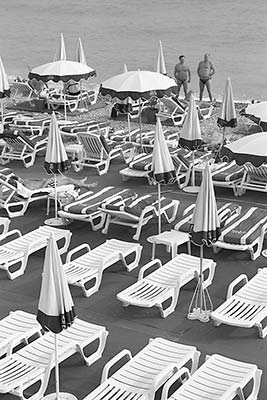
La Côte d’Azur
Map: Public Transportation Between Nice & Monaco
A hundred years ago, celebrities from London to Moscow flocked to the French Riviera to socialize, gamble, and escape the dreary weather at home. Today, budget vacationers and heat-seeking Europeans fill belle époque resorts at France’s most sought-after fun-in-the-sun destination.
The region got its nickname from turn-of-the-20th-century vacationing Brits, who simply extended the Italian Riviera west to France to include Nice. Today, the Riviera label stretches even farther westward, running from the Italian border to St-Tropez. To the French, this summer fun zone is known for the dazzling azure color of the sea along this coast: La Côte d’Azur. All of my French Riviera destinations are on the sea, except for a few hill towns and the Gorges du Verdon.
This sunny sliver of land has been inhabited for more than 3,000 years. Ligurians were first, then Greeks, then Romans—who, as usual, had the greatest impact. After the fall of Rome, Nice became an important city in the Kingdom of Provence (along with Marseille and Arles). In the 14th century Nice’s leaders voted to join the duke of Savoy’s mountainous kingdom (also including several regions of northern Italy), which would later evolve into the Kingdom of Sardinia. It was not until 1860 that Nice (and Savoy) became a part of France—the result of a plebiscite. (The “vote” was made possible because the King of Sardinia had to trade the region to France as a quid pro quo for Napoleon III’s support of the Italian states that wanted to break away from Austria to create modern Italy).
Nice has world-class museums, a splendid beachfront promenade, a seductive old town, and all the drawbacks of a major city (traffic, crime, pollution, and so on). The day-trip possibilities are easy and exciting: Monaco offers a royal welcome and a fairy-tale past; Antibes has a thriving port and silky sand beaches; and image-conscious Cannes is the Riviera’s self-appointed queen, with an elegant veneer hiding...very little. Yacht-happy St-Tropez swims alone an hour west. The Riviera’s overlooked interior transports travelers to a world apart, with cliff-hanging villages, steep canyons, and alpine scenery—a refreshing alternative to the beach scene.
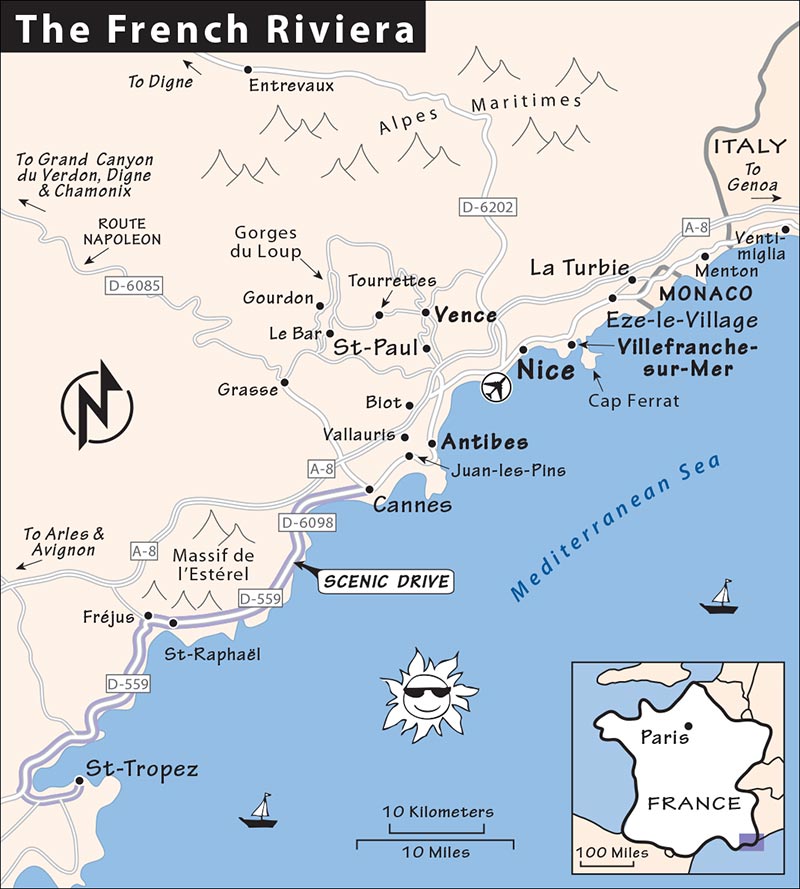
My favorite home bases are Nice, Antibes, and Villefranche-sur-Mer.
Nice is the region’s capital and France’s fifth-largest city. With convenient train and bus connections to most regional sights, this is the most practical base for train travelers. Urban Nice also has museums, a beach scene that rocks, the best selection of hotels in all price ranges, and good nightlife options. A car is a headache in Nice.
Nearby Antibes is smaller, with a bustling center, a lively night scene, great sandy beaches, grand vistas, good walking trails, and a stellar Picasso museum. Antibes has frequent train service to Nice and Monaco, and good connections by train or car to Grasse. It’s the most convenient overnight stop for drivers, with light traffic and easy hotel parking.
Villefranche-sur-Mer is the romantic’s choice, with a serene setting and small-town warmth. It has sand-pebble beaches; quick public transportation to Nice, Monaco, and Cap Ferrat; and a small selection of hotels and good restaurants in most price ranges.
Ideally, allow a day and a half for Nice itself, an afternoon to explore inland hill towns, a full day for Italianesque Villefranche-sur-Mer and lovely Cap Ferrat, a day for Monaco and the Corniches (including Eze-le-Village), and—if time allows—a day for Antibes and maybe Cannes. If you must do St-Tropez, visit it while traveling to or from destinations farther west (such as Cassis, Aix-en-Provence, and Arles) and avoid it on weekend afternoons, as well as all summer.
Monaco is radiant at night, and Antibes works well by day (good beaches and hiking) and night (fine choice of restaurants and a lively after-hours scene). Hill-town-loving naturalists should add a night or two inland to explore the charming hill-capping hamlets near Vence.
Depending on the amount of time you have in the Riviera, here are my recommended priorities:
| 3 days: | Nice, Villefranche-sur-Mer with Cap Ferrat, and Monaco |
| 5 days, add: | Antibes and hill towns near Vence |
| 7 days, add: | Grand Canyon du Verdon and/or just slow down |
Medical Help: Riviera Medical Services has a list of English-speaking physicians all along the Riviera. They can help you make an appointment or call an ambulance (tel. 04 93 26 12 70, www.rivieramedical.com).
Sightseeing Tips: Mondays and Tuesdays can frustrate market lovers and museumgoers. Closed on Monday: Nice’s Modern and Contemporary Art Museum, Fine Arts Museum, and Cours Saleya produce and flower market; Antibes’ Picasso Museum and market hall (Sept-May). Closed on Tuesday: Chagall, Matisse, Masséna, and Archaeological museums in Nice; Renoir Museum in Cagnes-sur-Mer. Matisse’s Chapel of the Rosary in Vence is closed Sunday and Monday and in the morning on Wednesday and Saturday.
The French Riviera Pass includes entry to many Riviera sights and activities, including Nice’s Chagall Museum, Monaco’s Oceanography Museum, and Villa Ephrussi de Rothschild on Cap Ferrat (€26/24 hours, €38/48 hours, €56/72 hours, tel. 04 92 14 46 14, http://en.frenchrivierapass.com). This pass is worth paying for if you have an aggressive sightseeing plan or want to do some bigger-ticket items like the included Le Grand Tour Bus in Nice (see here) or the Trans Côte d’Azur cruise (see here).
A €10 combo-ticket for Nice covers all of the city’s museums, except the Chagall Museum.
Events: The Riviera is famous for staging major events. Unless you’re actually taking part in the festivities, these occasions give you only room shortages and traffic jams. Here are the three biggies: Nice Carnival (two weeks in Feb, www.nicecarnaval.com), Cannes Film Festival (12 days in mid-May, www.festival-cannes.com), and the Grand Prix of Monaco (4 days in late May, www.acm.mc). To accommodate the busy schedules of the rich and famous (and really mess up a lot of normal people), the film festival and car race often overlap.
Cruise-Ship Sightseeing: The French Riviera is a popular cruise destination. Arriving ships are divided about evenly between Nice, Villefranche-sur-Mer, and Monaco (for arrival help, see the “Connections” section at the end of each of those chapters). Because these three ports line up conveniently along a 10-mile stretch of coast—easily connected by train or bus—from any of them, those arriving by cruise have the Riviera by the tail. Hiring a local guide helps make the most of cruisers’ limited time in port (see “Tours in the Riviera,” later). For in-depth coverage, consider my guidebook, Rick Steves Mediterranean Cruise Ports.
Trains and buses do a good job of connecting places along the coast, with bonus views along many routes. Buses also provide reasonable service to some inland hill towns. Nice makes the most convenient base for day trips, though public transport also works well from Riviera towns such as Antibes and Villefranche-sur-Mer. Driving can be challenging in this congested region (traffic, parking, etc.).
In the Riviera, buses are often less expensive and more convenient while trains are faster and more expensive. For an overview of the most useful train and bus connections, see the “Public Transportation in the French Riviera” chart later (confirm all connections and last train/bus times locally). You’ll also find details under each destination’s “Connections” section. For a scenic inland train ride, take the narrow-gauge train into the Alps (see here).
If taking the train or bus, have coins handy. Ticket machines don’t take some US credit cards or any euro bills, smaller train stations may be unstaffed, and bus drivers can’t make change for large bills.
Buses: Most of the area’s top destinations are connected by bus, and tickets are cheap. This is an amazing deal in the Riviera. Any one-way bus or tram ticket costs €1.50 (€10 for 10 tickets) whether you’re riding just within Nice or to Villefranche-sur-Mer, Monaco, Antibes, or even Grasse. This ticket is good for 74 minutes of travel in one direction anywhere within the bus system (but does not cover airport buses). Outside of the Inland Riviera, you can buy a single bus ticket from the driver or from machines at stops, and validate it in the machine on board (10-ride or all-day tickets must be purchased at machines or at Lignes d’Azur offices). At Inland Riviera destinations such as Vence and St.-Paul-de-Vence, buy bus tickets at a tabac. Your ticket allows transfers between the buses of the Lignes d’Azur (the region’s main bus company, www.lignesdazur.com) and the TAM (Transports Alpes-Maritimes); if you board a TAM bus and need a transfer, ask for un ticket correspondance. A €5 all-day ticket is good on Nice’s city buses, tramway, and selected buses serving nearby destinations (such as Villefranche, Cap Ferrat, and Eze-le-Village). The general rule of thumb: If the bus number has one or two digits, it’s covered with the all-day ticket; with three digits it’s not.
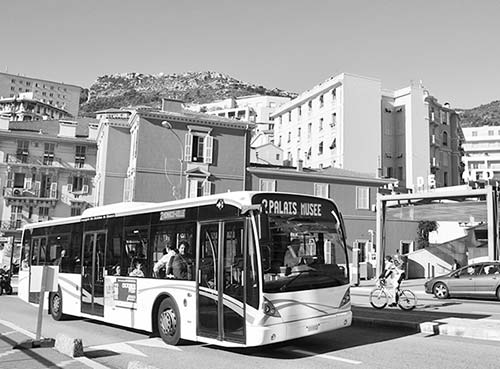
You’ll be able to get around most of the Riviera on the following major bus routes:
• Bus #100 runs eastbound from Nice along the Low Corniche (3-4/hour) stopping in Villefranche-sur-Mer (20 minutes), Beaulieu-sur-Mer (Villa Kérylos; 30 minutes), Eze-Bord-de-Mer (40 minutes, transfer to #83 to Eze-le-Village), Monaco (1 hour), and Menton (1.5 hours).
• Bus #81 runs eastbound from Nice (2-3/hour) to Villefranche-sur-Mer (15 minutes), Beaulieu-sur-Mer (Villa Kérylos; 20 minutes), and all Cap Ferrat stops, ending at St-Jean-Cap-Ferrat (30 minutes).
• Buses #82 and #112 run from Nice and upper Villefranche-sur-Mer to Eze-le-Village (together they depart about hourly; only #82 runs on Sunday; 30 minutes to reach Eze from Nice). Bus #112, which runs along the scenic Middle Corniche, continues from Eze-le-Village to Monte Carlo in Monaco (6/day, none on Sun, 20 minutes).
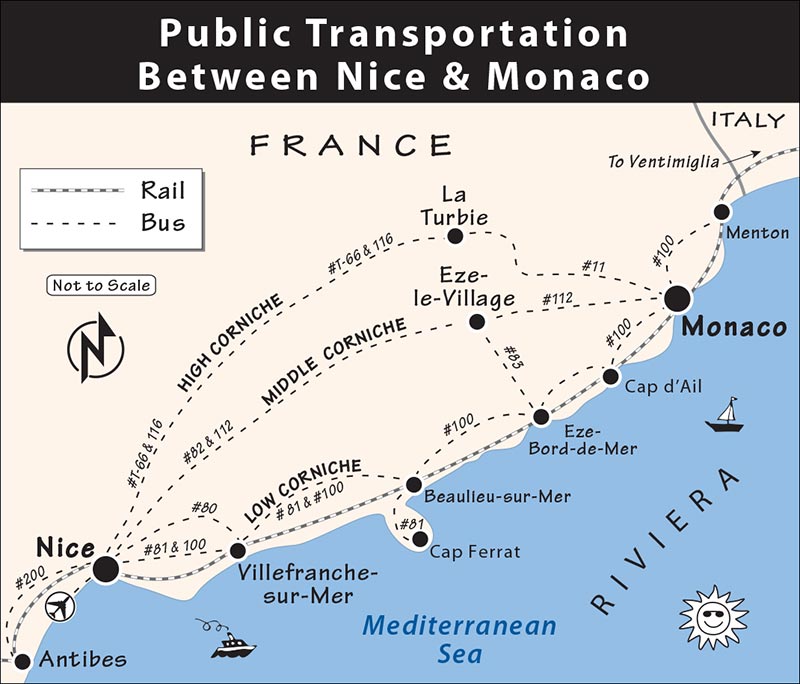
• Bus #200 goes from Nice westbound (4/hour Mon-Sat, 2/hour Sun) to Cagnes-sur-Mer (1 hour), Biot (1.25 hours), Antibes (1.5 hours), and Cannes (2 hours).
• For the inland towns, bus #400 runs from Nice (2/hour) to St-Paul-de-Vence (45 minutes) and Vence (50 minutes); buses #500/510 run between Vence and Grasse (6/day, 50 minutes).
Trains: These are more expensive but much faster than the bus (Nice to Monaco by train is about €4), and there’s no quicker way to move about the Riviera (http://en.voyages-sncf.com). Speedy trains link the Riviera’s beachfront destinations—Cannes, Antibes, Nice, Villefranche-sur-Mer, Monaco, Menton, and the inland perfume town of Grasse. (Never board a train without a ticket or valid pass—fare inspectors accept no excuses. The minimum fine: €70.)
This is France’s most challenging region to drive in. Beautifully distracting vistas (natural and human), loads of Sunday-driver tourists, and every hour being lush-hour in the summer make for a dangerous combination. Parking can be exasperating. Bring lots of coins and patience.
The Riviera is awash with scenic roads. To sample some of the Riviera’s best scenery, connect Provence and the Riviera by driving the splendid coastal road between Cannes and Fréjus (D-6098 from Cannes/D-559 from Fréjus). Once in the Riviera, the most scenic and thrilling road trip is along the three coastal roads—called “corniches”—between Nice and Monaco (see here). Farther inland, take my recommended inland hill-towns drive (on here). Farther yet, explore the Grand Canyon du Verdon, with breathtaking gorges and alpine scenery. But for basic sightseeing between Monaco and Cannes, I’d ditch the car and use trains and buses.
Trans Côte d’Azur offers seasonal boat service from Nice to Monaco or to St-Tropez, as well as between Cannes and St-Tropez (tel. 04 92 98 71 30, www.trans-cote-azur.com). For details, see the “By Boat” section under Nice Connections (here).
These two energetic and delightful women adore educating people about this area’s culture and history, and have comfortable minibuses: Sylvie Di Cristo (€600/day, €350/half-day for up to 8 people, mobile 06 09 88 83 83, http://frenchrivieraguides.com, dicristosylvie@gmail.com) and Ingrid Schmucker (€490/day for 2 people, €530/day for 3-4 people, €580 for 5-6, €200/half-day to explore old Nice on foot, mobile 06 14 83 03 33, https://kultours.fr, kultours06@gmail.com). Their websites explain their programs well, and they are happy to adapt to your interests.
Charming Fouad Zarrou runs France Azur Excursions and offers a fun experience. His tours are more about exploring the region’s natural beauty, food, and wine than its cultural history. He provides comfortable transportation in his minivan (figure €300/half-day, mobile 06 20 68 10 70, http://franceazurexcursions.com, contact@franceazurexcursions.com).
Most hotels and TIs have information on economical shared minivan excursions from Nice (per person: roughly €50-70/half-day, €80-120/day).
For a guided tour of Nice or the region using public transit or with a guide joining you in your rental car, consider Pascale Rucker, an art-loving guide with 25 years of experience who teaches with the joy and wonder of a flower child (€160/half-day, €260/day, mobile 06 16 24 29 52, pascalerucker@gmail.com). Boba Vukadinovic-Millet is an effective teacher, ideal for those wanting to dive more deeply into the region’s history and art. She can arrange chauffeur-driven rental options (car, minivan, minibus, bus) for you if needed (from €250/half-day, from €350/day, mobile 06 27 45 68 39, www.yourguideboba.com, boba@yourguideboba.com).
For food and wine walking tours and cooking classes offered in Nice, see here.
The list of artists who have painted the Riviera reads like a Who’s Who of 20th-century art. Pierre-Auguste Renoir, Henri Matisse, Marc Chagall, Georges Braque, Raoul Dufy, Fernand Léger, and Pablo Picasso all lived and worked here—and raved about the region’s wonderful light. Their simple, semi-abstract, and—most importantly—colorful works reflect the pleasurable atmosphere of the Riviera. You’ll experience the same landscapes they painted in this bright, sun-drenched region, punctuated with views of the “azure sea.” Try to imagine the Riviera with a fraction of the people and development you see today.
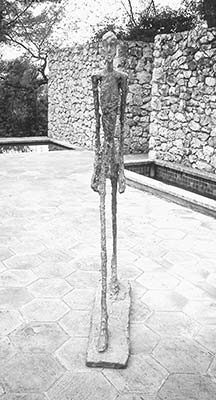
But the artists were mostly drawn to the uncomplicated lifestyle of fishermen and farmers that has reigned here since time began. As the artists grew older, they retired in the sun, turned their backs on modern art’s “isms,” and painted with the wide-eyed wonder of children, using bright primary colors, basic outlines, and simple subjects.
A collection of modern- and contemporary-art museums (many described in this book) dot the Riviera, allowing art lovers to appreciate these masters’ works while immersed in the same sun and culture that inspired them. Many of the museums were designed to blend pieces with the surrounding views, gardens, and fountains, thus highlighting that modern art is not only stimulating, but sometimes simply beautiful.
Entire books have been written about the modern-art galleries of the Riviera. If you’re a fan, do some studying before your visit to be sure you know about that far-out museum of your dreams. If you’ve never enjoyed modern art, the two best places to give it a try here are the Fondation Maeght in St-Paul-de-Vence and the Chagall Museum in Nice.
The Riviera adds an Italian-Mediterranean flair to the food of Provence. While many of the same dishes served in Provence are available in the Riviera (see “Provence’s Cuisine Scene” on here), there are differences, especially if you look for anything Italian or from the sea. Proximity to the water and historic ties to Italy are clear in this region’s dishes.
That said, memorable restaurants that showcase the Riviera’s cuisine can be difficult to find. Because most visitors come more for the sun than the food, and because the clientele is predominantly international, many restaurants aim for the middle and are hard to distinguish from one another. Trust my recommendations.
A fresh and colorful salade niçoise makes the perfect introduction to the Riviera’s cuisine. Surprisingly, the authentic version contains no potatoes or green beans but consists of ripe tomatoes, plenty of raw vegetables (such as radishes, green peppers, celery, and perhaps artichoke or fava beans), as well as tuna (usually canned), anchovy, hard-boiled egg, and olives. This is my go-to salad for a tasty, healthy, cheap (€14), and fast lunch. I like to spend a couple of extra euros and eat it in a place with a nice ambience and view.
For lunch on the go, look for a pan bagnat (like a salade niçoise stuffed into a crusty roll drizzled with olive oil and wine vinegar). Other tasty bread treats include pissaladière (bread dough topped with caramelized onions, olives, and anchovies), fougasse (a spindly, lace-like bread sometimes flavored with nuts, herbs, olives, or ham), and socca (a thin chickpea-and-olive-oil crêpe, seasoned with pepper and often served in a paper cone by street vendors).
Said to have been invented in Nice, ravioli and potato gnocchi can be found on menus everywhere (ravioli can be stuffed with a variety of fillings, but the classic local version is made with beef and Swiss chard).
Bouillabaisse is the Riviera’s most famous dish; you’ll find it in seafront villages and cities. It’s a spicy fish stew based on recipes handed down from sailors in Marseille. It must contain at least four types of fresh fish, though most have five to twelve kinds. A true bouillabaisse never has shellfish. The fish—cooked in a tomato-and-onion-based stock and flavored with saffron (and sometimes anise and orange)—is separated from the stock, and the two are served as separate courses. Diners then heighten the soup’s flavor by adding toasted croutons slathered with rouille sauce (a thickened reddish mayonnaise heady with garlic and spicy peppers) and topped with grated parmesan or Emmental cheese. This dish often requires a minimum order of two and can cost up to €40-60 per person.
Far less pricey than bouillabaisse and worth trying is the local soupe de poissons (fish soup). It’s a creamy soup flavored like bouillabaisse, with anise and orange, and served with croutons and rouille sauce (but has no chunks of fish). For a less colorful but still tasty soup, look for bourride, a creamy fish concoction thickened with an aioli sauce instead of the red rouille.
The Riviera specializes in all sorts of fish and shellfish. Options include fruits de mer (platters of seafood—including tiny shellfish, from which you get the edible part only by sucking really hard), herb-infused mussels, stuffed sardines, squid (slowly simmered with tomatoes and herbs), and tuna (thon). The popular loup flambé au fenouil is grilled sea bass, flavored with fennel and torched with pastis prior to serving.
For a truly local dessert, try the Niçoise specialty tourte de blettes, a sugar-dusted pie with a sweet filling of Swiss chard, rum-soaked raisins, pine nuts, and apple. In St-Tropez, the tropézienne is a brioche topped with sugar crystals and sandwiching with an airy vanilla cream. Desserts on the Riviera make use of the abundant local fruits, especially citrus in winter, and regional flavors such as orange flower water.
For details on dining in France’s restaurants, cafés, and brasseries, getting takeout, and assembling a picnic—as well as a rundown of French cuisine—see the “Eating” section in the Practicalities chapter (here).
Do as everyone else does: Drink wines from Provence. Bandol (red) and cassis (white) are popular and from a region nearly on the Riviera. The only wines made in the Riviera are Bellet rosé and white, the latter often found in fish-shaped bottles. For more on Provençal wines, see here.